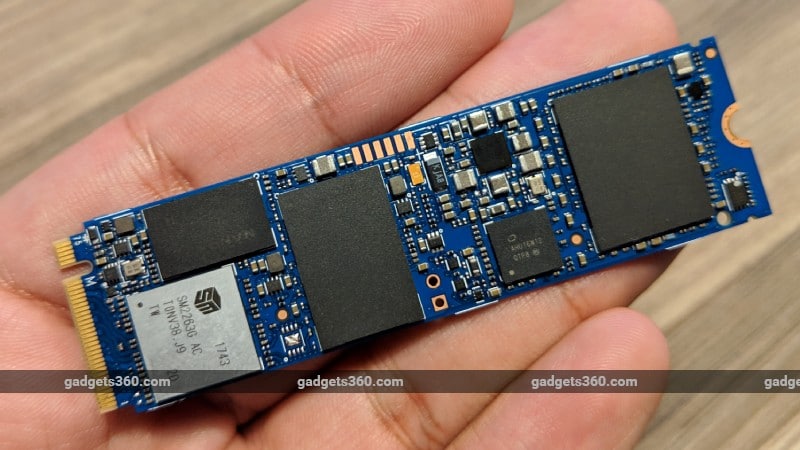- Home
- Laptops
- Laptops News
- Intel Optane Memory H10 Hybrid SSD With QLC Flash Coming to Thin and Light Laptops Soon
Intel Optane Memory H10 Hybrid SSD With QLC Flash Coming to Thin and Light Laptops Soon

Intel has announced details of the upcoming Optane Memory H10 SSD that it first unveiled at CES 2019. This device combines an Intel's high-speed 3D Xpoint memory with high-density QLC (Quad Level Cell) NAND flash on a single M.2 module. Intel has announced that this drive will soon come to the market in pre-built PCs from multiple major manufacturers including Dell, HP, Acer, and Asus this quarter, and will also be available in retail. Intel had earlier indicated that the Optane Memory H10 is most suitable for thin-and-light laptops and small-form-factor desktops which only have room for one M.2 slot, so it's likely that manufacturers will launch such products first.
The Optane Memory H10 device combines an Optane Memory drive and QLC NAND SSD, but both operate independently with their own controllers on the M.2 module, and each one has access to two of the module's four PCIe x16 lanes. Intel's RST (Rapid Storage Technology) driver makes both devices appear to Windows 10 as a single drive, and handles caching as well as acceleration of reads and writes. However, the two parts of the module do not communicate directly with each other.
In terms of functionality, the Optane Memory H10 is exactly like having a standard Optane Memory module with a separate SSD. Intel says it chose QLC flash because of its cost and density advantages. This is not the same as Intel's speedy Optane SSDs such as the Optane SSD 900p, or the recently announced Optane Persistent Memory modules which use the same underlying 3D Xpoint technology.
Three capacity options will be available: 16GB + 256GB, 32GB + 512GB, and 32GB + 1TB. Speeds vary by capacity, with maximum sequential read speeds ranging from 1450MBps to 2400MBps, and sequential writes ranging from 650MBps to 1800MBps. Power consumption when active ranges between 5.3W and 5.8W. Endurance measured in Terabytes Written is 75TBW for the base variant, 150TBW for the middle one, and 300TBW for the top-end one. They all have five-year warranties.
The Optane Memory H10 needs a motherboard that supports PCIe bifurcation thanks to the use of two separate controllers on one module. An 8th Gen Intel Core processor and Intel 300-series platform controller are the minimum system requirements. Considering the timeline announced, laptops could be demonstrated at this year's Computex exhibition in late May.
Intel says the Optane Memory H10 is ideally suited for consumer workloads which generally do not push above queue depths of 2. Users can expect to be able to boot into Windows, launch programs, and open documents, and multitask much quicker.
For the latest tech news and reviews, follow Gadgets 360 on X, Facebook, WhatsApp, Threads and Google News. For the latest videos on gadgets and tech, subscribe to our YouTube channel. If you want to know everything about top influencers, follow our in-house Who'sThat360 on Instagram and YouTube.
Related Stories
- Samsung Galaxy Unpacked 2025
- ChatGPT
- Redmi Note 14 Pro+
- iPhone 16
- Apple Vision Pro
- Oneplus 12
- OnePlus Nord CE 3 Lite 5G
- iPhone 13
- Xiaomi 14 Pro
- Oppo Find N3
- Tecno Spark Go (2023)
- Realme V30
- Best Phones Under 25000
- Samsung Galaxy S24 Series
- Cryptocurrency
- iQoo 12
- Samsung Galaxy S24 Ultra
- Giottus
- Samsung Galaxy Z Flip 5
- Apple 'Scary Fast'
- Housefull 5
- GoPro Hero 12 Black Review
- Invincible Season 2
- JioGlass
- HD Ready TV
- Laptop Under 50000
- Smartwatch Under 10000
- Latest Mobile Phones
- Compare Phones
- Realme Narzo 80x 5G
- Realme Narzo 80 Pro 5G
- OnePlus 13T
- Honor 400 Lite
- Honor Play 60m
- Honor Play 60
- Poco C71
- Lava Bold 5G
- Asus Vivobook 16 (AMD, 2025)
- Asus Zenbook S16 (AMD, 2025)
- Samsung Galaxy Tab S10 FE+
- Samsung Galaxy Tab S10 FE
- Huawei Watch Fit 3
- Garmin Instinct 3
- Haier M80F Mini LED 4K
- Haier M95E
- Nintendo Switch 2
- Sony PlayStation 5 Pro
- Whirlpool 1.5 Ton 3 Star Inverter Split AC (SAI18K38DC0)
- Whirlpool 1.5 Ton 5 Star Inverter Split AC (SAI17B54SED0)















